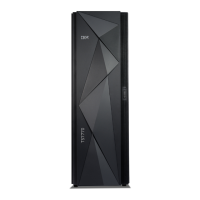August 15, 2017
© Copyright IBM Corporation, 2017 Page 54 of 117
volsers to be recovered. This includes both logical and physical volumes. If any conflicts are
encountered during the recovery process, the volsers that conflict will not be recovered and a warning
message will be displayed in the recovery status panel on the recovery TS7700 management interface.
This also means that you cannot use the same library for both the source and recovery TS7700.
• On pre 8.5 systems or systems with 3494 attached libraries, if there is another VTS/TS7700 or native
drives on the other partition of the library manager, it must not use the same Data Class, Storage Class,
Management Class or Storage Group names that were defined on the source TS7700 if the actions for
the names are different. As part of the copy export recovery process, the storage construct names and
their definitions from the recovered database will be loaded into the library manager database. If the
same construct name is already defined, it actions will be replaced by the actions from the source
TS7700.
• On systems running 8.5 and higher with a 3584 attached libraries, if there are other logical partitions on
the 3584 library, the physical volumes in the other partitions must not overlap with the volsers to be
recovered. This also means that you cannot use the same library for both the source and recovery
TS7700.
• Other than the physical drive compatibility requirements listed above, the source and recovery TS7700
can have a different configuration of features, ie different cache capabilities, performance enablement
features, etc..
• You will need to add scratch physical volumes to the recovery TS7700 even if you are only going to be
reading data. A minimum of 2 scratch volumes per defined pool in the TS7700 is needed to prevent the
TS7700 from entering the out of scratch state. In the out of scratch state, logical volume mounts are not
allowed. When adding scratch physical volumes to the recovery TS7700, do so only after the recovery
has been performed and the recovery TS7700 is ready to be brought online to its attached hosts,
otherwise their inventory records will have been erased during the recovery process. Physical volumes
that are part of copy export set and are now empty can not be counted as scratch.
• To shorten the time it takes to execute copy export recovery, it is recommended that after a recovery
test; perform the erasure portion of copy export recovery. This may also eliminate logical volume
overlap issues when two TS7700s used for recovery testing are attached to the same library manager. It
is also useful to perform the erasure portion of copy export recovery if the TS7700 is subsequently going
to be used for new workloads and not for disaster recovery anymore.
• After you have completed performing copy export recovery and the TS7700 is online to its hosts, you
will need to insert logical volumes to be used as scratch volumes before you can write new data.
• If the recovery is for a real disaster (rather than just a test), you will want to verify that the actions
defined for the storage management constructs that were restored during the recovery are what you want
to continue to use.

